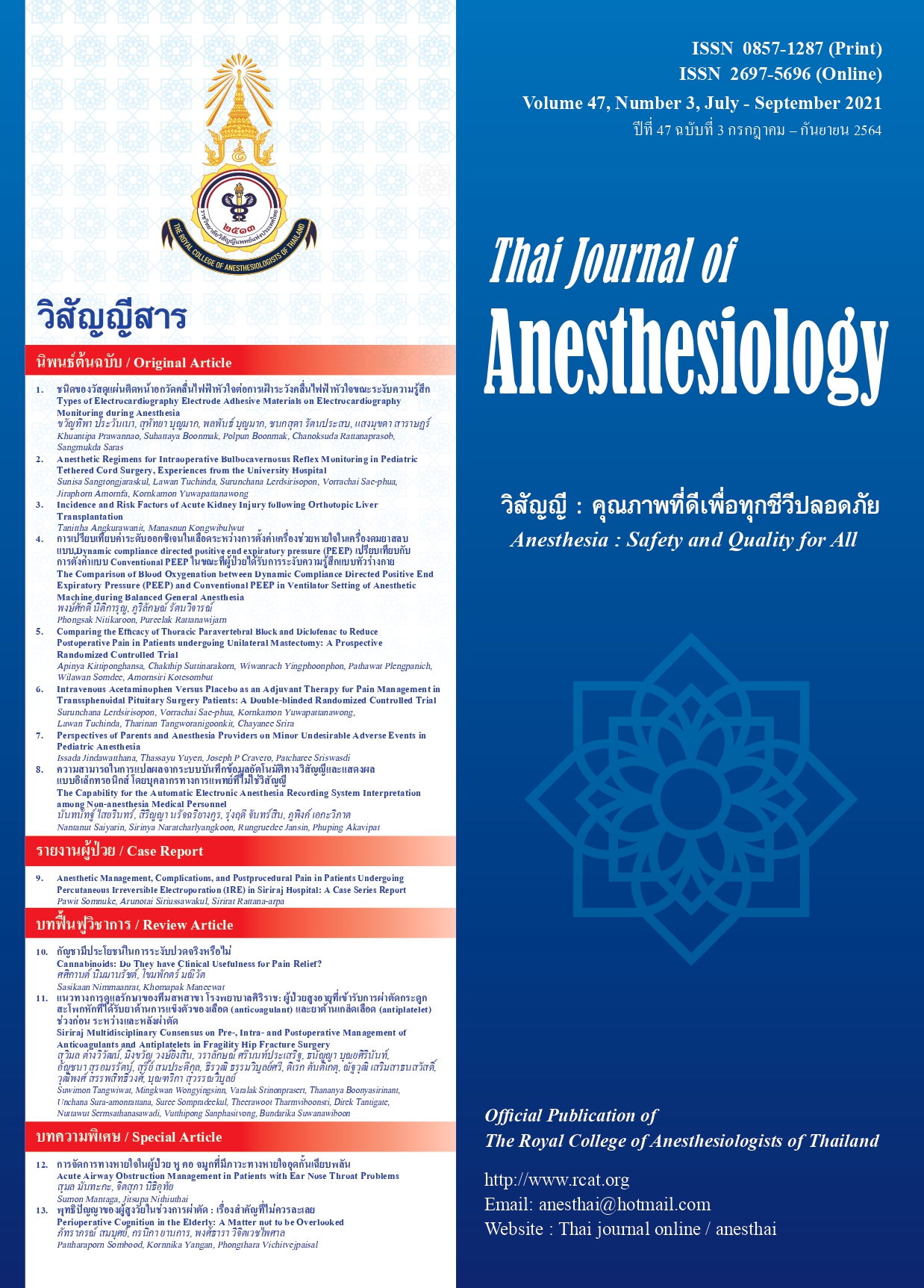Comparing the Efficacy of Thoracic Paravertebral Block and Diclofenac to Reduce Postoperative Pain in Patients undergoing Unilateral Mastectomy: A Prospective Randomized Controlled Trial
Main Article Content
Abstract
Background: Breast surgery is associated with postoperative pain, nausea, and chronic pain. Thoracic paravertebral block (TPVB) and diclofenac are analgesic adjuvant to manage postoperative pain. Objectives: To compare the efficacy of TPVB and intravenous diclofenac to reduce postoperative morphine consumption after breast surgery. Methods: Forty-four patients undergoing unilateral mastectomy under general anesthesia were randomly allocated into two groups: group PG (n=22) received TPVB using 0.25% levobupivacaine or group NG (n=22) received diclofenac 150 mg intravenously. The primary outcome was consumption of morphine during the first 24 h postoperatively. Secondary outcomes were consumption of morphine within 48 h postoperatively, numerical rating scale at 24 h and 48 h postoperatively at rest and movement, and complications during the first 24 h postoperatively Background: Breast surgery is associated with postoperative pain, nausea, and chronic pain. Thoracic paravertebral block (TPVB) and diclofenac are analgesic adjuvant to manage postoperative pain. Objectives: To compare the efficacy of TPVB and intravenous diclofenac to reduce postoperative morphine consumption after breast surgery. Methods: Forty-four patients undergoing unilateral mastectomy under general anesthesia were randomly allocated into two groups: group PG (n=22) received TPVB using 0.25% levobupivacaine or group NG (n=22) received diclofenac 150 mg intravenously. The primary outcome was consumption of morphine during the first 24 h postoperatively. Secondary outcomes were consumption of morphine within 48 h postoperatively, numerical rating scale at 24 h and 48 h postoperatively at rest and movement, and complications during the first 24 h postoperatively
Article Details

This work is licensed under a Creative Commons Attribution-NonCommercial-NoDerivatives 4.0 International License.
References
PK. Efficacy and safety of paravertebral blocks in breast
surgery: a meta-analysis of randomized controlled trials. Br J
Anaesth 2010;105:842-52.
2. Boughey JC, Goravanchi F, Parris RN, et al. Prospective
randomized trial of paravertebral block for patients undergoing
breast cancer surgery. Am J Surg 2009;198:720-5.
3. Klein SM, Bergh A, Steele SM, Georgiade GS, Greengrass
RA. Thoracic paravertebral block for breast surgery. Anesth
Analg 2000;90:1402-5.
4. Bansal P, Saxena KN, Taneja B, Sareen B. A comparative
randomized study of paravertebral block versus wound
infiltration of bupivacaine in modified radical mastectomy.
J Anaesthesiol Clin Pharmacol 2012;28:76-80.
5. Cheng GS, Ilfeld BM. An Evidence-based review of the
efficacy of perioperative analgesic techniques for breast
cancer-related surgery. Pain Med 2017;18:1344-65.
6. Arunaku P, Ruksa A. General anesthesia with thoracic
paravertebral block for modified radical mastectomy. J Med
Assoc Thai 2010;93:S149-53.
7. Exadaktylos AK, Buggy DJ, Moriarty DC, Mascha E, Sessler
DI. Can anesthetic technique for primary breast cancer
surgery affect recurrence or metastasis? Anesthesiology
2006;105:660-4.
8. Legeby M, Sandelin K, Wickman M, Olofsson C. Analgesic
efficacy of diclofenac in combination with morphine and
paracetamol after mastectomy and immediate breast
reconstruction. Acta Anaesth Scand 2005;49:1360-6.
9. Forget P, Bentin C, Machiels JP, Berliere M, Coulie PG, De
Kock M. Intraoperative use of ketorolac or diclofenac is
associated with improved disease-free survival and overall
survival in conservative breast cancer surgery. Br J Anaesth
2014;113:82-7.
10. Sun M, Liao Q, Wen L, Yan X, Zhang F, Ouyang W. Effect of
perioperative intravenous flurbiprofen axetil on chronic
postmastectomy pain. Zhong Nan Da Xue Xue Bao Yi Xue
Ban. 2013;38:653-60.
11. Kaur U, Shamshery C, Agarwal A, Prakash N, Valiveru RC,
Mishra P. Evaluation of postoperative pain in patients
undergoing modified radical mastectomy with pectoralis or
serratus-intercostal fascial plane blocks. Korean J
Anesthesiol 2020;73:425-33.
12. Kairaluoma PM, Bachmann MS, Rosenberg PH, Pere PJ.
Preincisional paravertebral block reduces the prevalence of
chronic pain after breast surgery. Anesth Analg 2006;103:703-8.
13. Das S, Bhattacharya P, Mandal MC, Mukhopadhyay S, Basu
SR, Mandol BK. Multiple-injection thoracic paravertebral
block as an alternative to general anaesthesia for elective
breast surgeries: a randomised controlled trial. Indian J
Anesth 2012;56:27-33.
14. Abdel-halim JMK. Continuous thoracic paravertebral block:
an adjunct to general anaesthesia in major breast surgery.
Egyptian J Anaesth 2011;27:83-7.
15. Moller JF, Nikolajsen L, Rodt SA, Ronning H, Carlsson PS.
Thoracic paravertebral block for breast cancer surgery:
a randomized double-blind study. Anesth Analg 2007;105:
1848-51.
16. Pusch F, Freitag H, Weinstabl C, Obwegeser R, Huber E,
Wildling E. Single-injection paravertebral block compared to
general anaesthesia in breast surgery. Acta Anaesthesiol
Scand 1999;43:770-4.
17. Richardson J, Lonnqvist PA. Thoracic paravertebral block.
Br J Anaesth 1998;81:230-8.
18. Sharma S, Chang DW, Koutz C, et al. Incidence of hematoma
associated with ketorolac after TRAM flap breast
reconstruction. Plast Reconstr Surg 2001;107:352-5.
19. Hynninen MS, Cheng DC, Hossain I, et al. Non-steroidal
anti-inflammatory drugs in treatment of postoperative pain
after cardiac surgery. Can J Anaesth 2000;47:1182-7.


